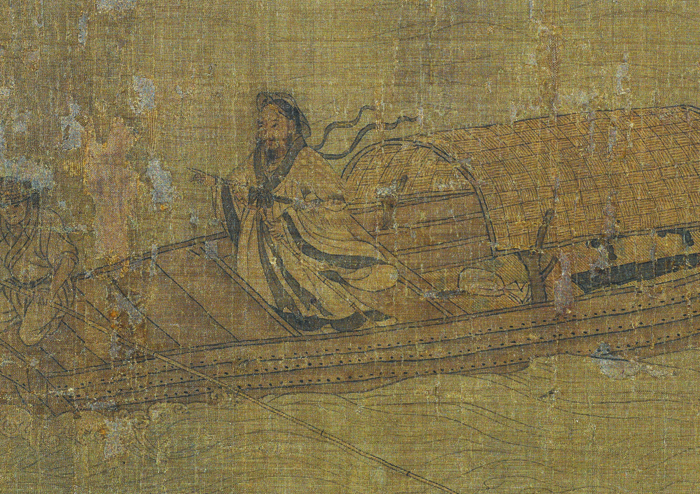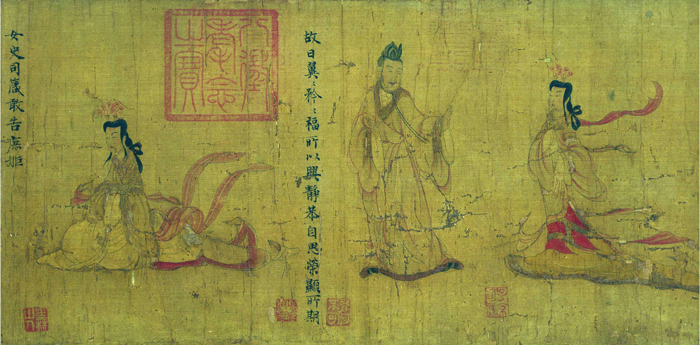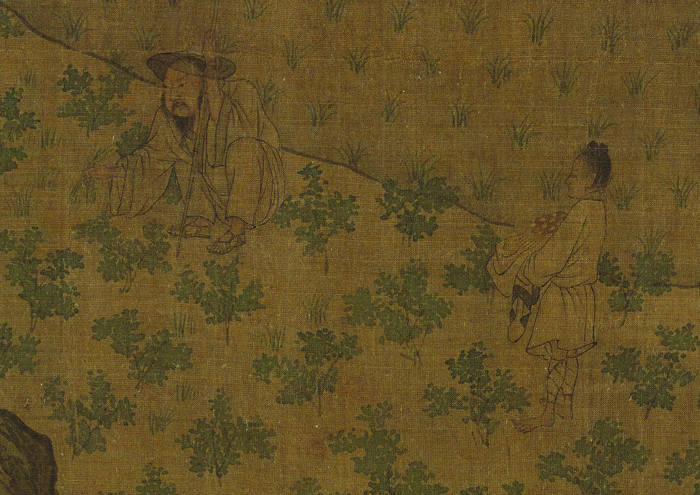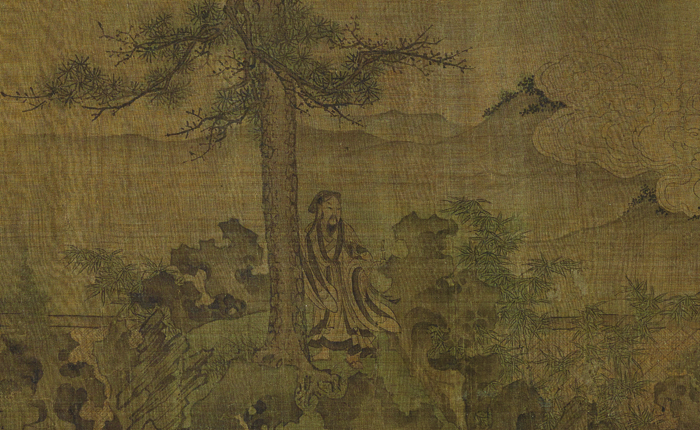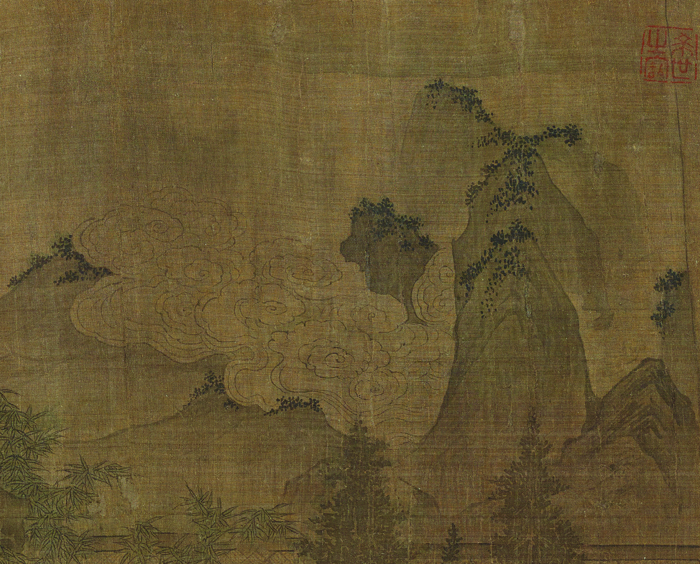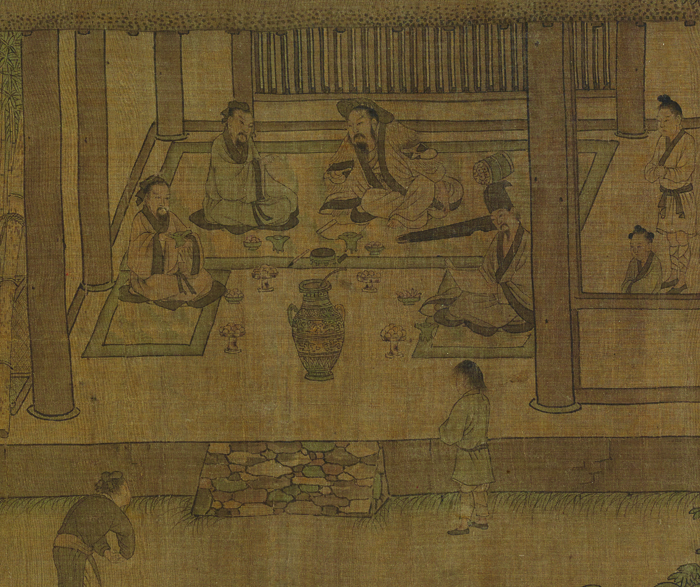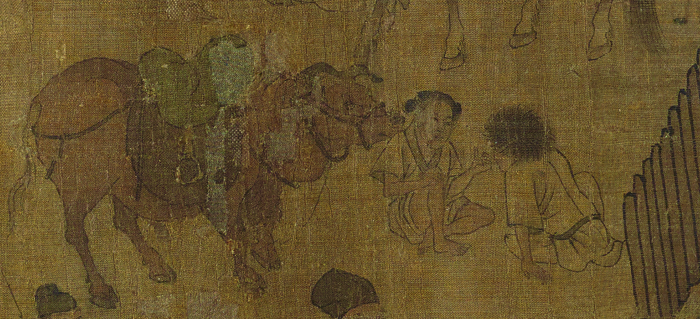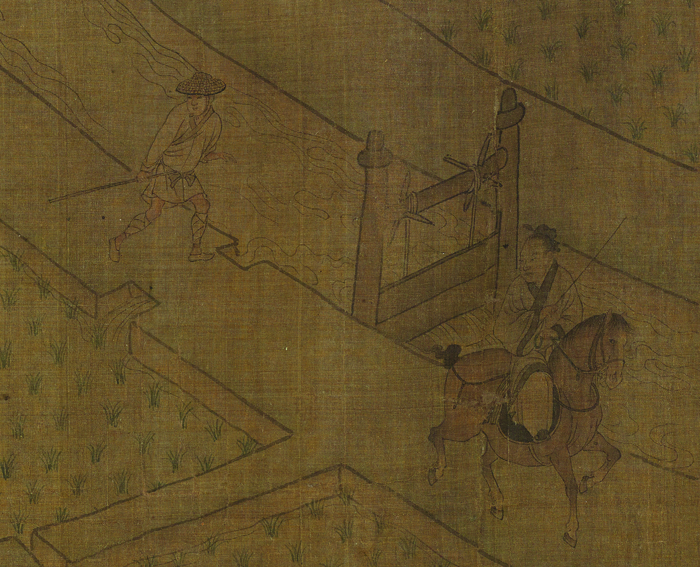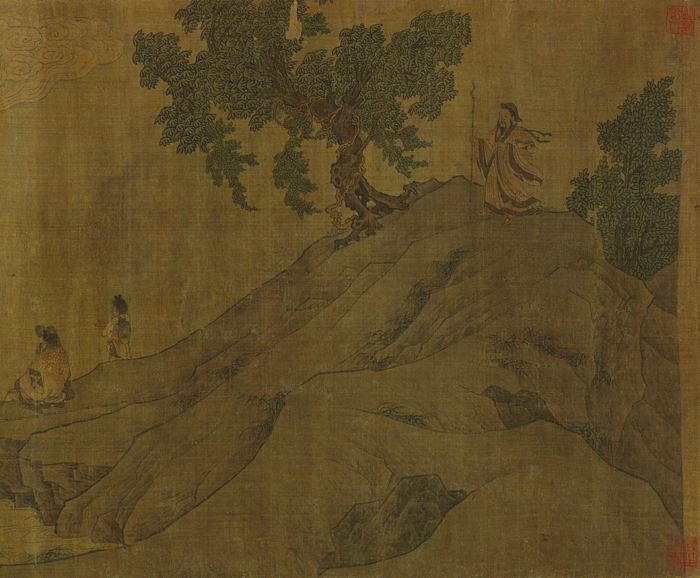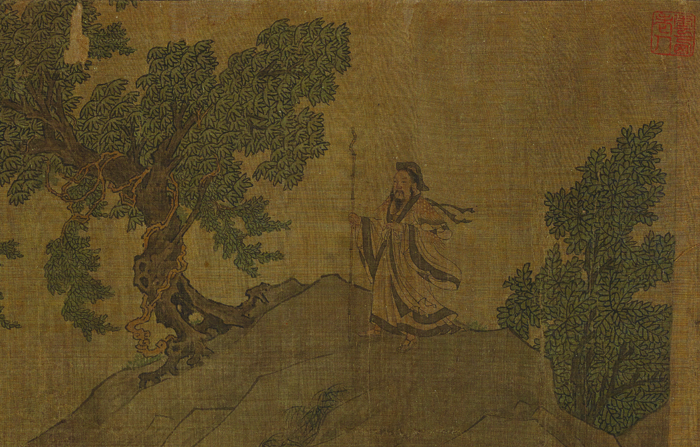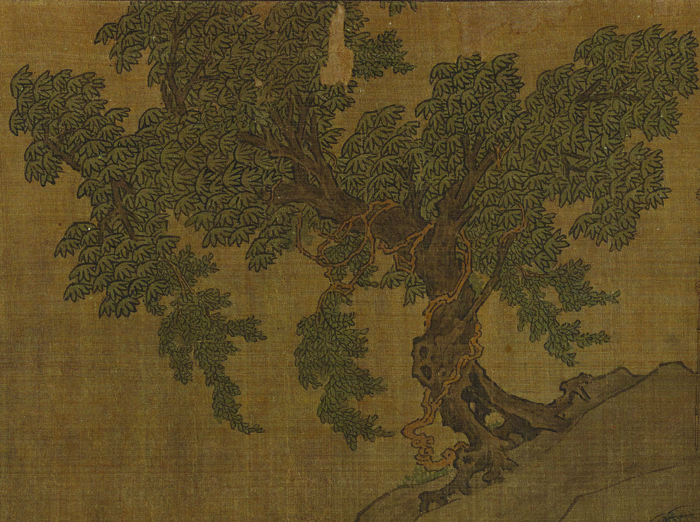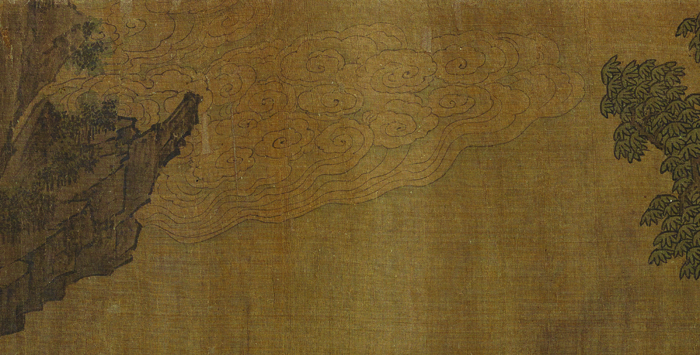In recent years, the study of artistic repetition—copying, imitation, emulation—has inspired theorization in a range of fields from Renaissance painting to the art of the Incas.1 In a variety of cultures, artists learned a style from their masters and continued working in that manner, passing it on to their apprentices. In traditions with written histories of art and a canon of masters, artists might model themselves consciously on a single master who was regarded as exemplifying the “best” for all time.2 In traditions lacking an established canon, it would be difficult to demonstrate that this was the case. Medieval religious painting, for example—East and West—sometimes juxtaposes elements from different periods in one work.3 In such cases, in the absence of clear evidence of theorization, Occam’s razor requires us to view such juxtapositions as the result of an indifference to art history, rather than a celebration of the historicity of styles. In some paintings of the Song period (960–1279), we also find styles from completely different periods juxtaposed in one painting, but in this case these practices cannot be ascribed to indifference, for there was an established canon, histories recording the development of styles, and a clear sense that naturalism marked a decisive advance over earlier styles. Moreover, as we shall see, the practice of citation was well theorized.
There can be little doubt that Song art critics regarded the development of more naturalistic styles as marking a watershed in the history of their own art. At the end of the Tang (618–907), Zhang Yanyuan 张彦远 (815–ca. 877) had noticed already that artists working in earlier times paid little mind to proportion, scale, or spatial depth, while his contemporaries were much better at achieving these effects. Zhang recognized, in other words, an evolutionary process in which artistic style was able to convey a more accurate sense of recession in space.4 Song-period critics generally credited the artist Li Cheng 李成 (919–967) with having developed a style that conveyed the sense of actually “being there”:
Connoisseurs regard Li’s paintings as records of actual scenes. In his painting Li Cheng was able to grasp the principles of Creation, transmitting his thoughts with every stroke so that he could brush in a thousand miles of scenery within an inch of space on the silk, or create the illusion of innumerable variations [in the surfaces of objects] with his brush. Peaks and mountain ranges appear in layers; his buildings and retreats set in the wilderness were especially fine. And when it came to woods and forests, dense or sparse, or the flow of water shallow or deep, it was as if you were really there.5
Another major critic, Guo Ruoxu 郭若虚 (11th century), observed the evolution of three-dimensional effects in the architectural painting of the tenth century and, moreover, regarded the post–Li Cheng landscapes of Song times as superior to those of all previous times.6 Spatial depth apparently was a key feature of the new naturalism and was recognized as an achievement that had evolved slowly over time, coming to a peak in Song times. It was this development that rendered all previous styles, in some sense, anachronistic.
Writing about the development of naturalistic styles in Song times, Richard Barnhart has recognized as much:
The Gu Kaizhi tradition of secular figure painting . . . was virtually moribund in the eleventh century . . . Similarly, Li Sixun, Wang Wei, and Lu Hong are rarely mentioned in the long interval between Jing Hao of circa 900 and the late eleventh century. Their relatively primitive landscape art had been thoroughly overshadowed by the great masters of the tenth and eleventh centuries . . . .7
Yet in the work of the literati of the Northern Song (960–1127), we find outdated styles juxtaposed with those naturalistic styles that had made the earlier modes obsolete. How should we explain this? Unlike the art of medieval China, these works were created on a foundation of two types of written theory: the literary theory of citation and new, historicist theories of social development. We will address the latter phenomenon first.
The Historicist View of History in Song Times
The historicist writing of Song times has attracted the attention of modern scholars only recently. Following upon a conference of leading historians on the nature of Song historical awareness, Thomas Lee has observed a new sense of “anachronism” in Song historical writing, adding that “the Song people were perhaps uniquely and deeply preoccupied with their own status in China’s past, and for that matter, the past of the humankind. It marks the first time that such a preoccupation stimulated a mass production of historical discourses.”8 He notes further that, thanks to the invention of printing and print culture, these new historical discourses were circulated widely among the literate.9
Peter Bol, who likewise attended that conference, elsewhere has observed that Song statesmen no longer viewed the past as a repository of models to be imitated, but rather “as a period and set of texts from which to derive general principles [about government and policy].”10 This approach to history can be found already in the writings of guwen 古文, or “plain-style” literati of the late Tang dynasty. Liu Zongyuan 柳宗元 (773–819) famously rejected the theory that feudalism (fengjian 封建) was invented by the sage kings. He maintained instead that history was driven by the “force of circumstance” (shizhilai 势之来), by which he meant the scarcity of resources, the human need for survival, and the various social and institutional adaptations to those conditions. Observing that humans are ill suited to survive as individuals, he systematically derived the development of social groupings, leadership hierarchies, and government itself from the force of circumstance.11
After reasoning that feudalism is a natural product of the struggle to survive in primitive conditions, Liu turned to historical records to demonstrate that feudalism nonetheless is inefficient, irrational, cruel, and prone to instability. He traced the source of these problems to the personalization of power in a feudal system.12 Liu proposed instead that meritocratic recruitment, with term limits and routine checks on officers, would yield better results because power would no longer be personalized. He did not maintain that a particular period was meritocratic and therefore should be imitated. He argued instead that a meritocratic system that paid officers in salaries rather than sinecures would be more stable because officers who abused their power could be removed.13 In other words, Liu treated the histories as a “set of texts from which to derive general principles” (to use Peter Bol’s words) to be applied rationally as social policy.
The guwen writers of the late Tang were admired greatly by leading Northern Song intellectuals, with many situating themselves in the guwen tradition. A remarkable example of historicist reasoning from that period appears in the writings of the polymath Shen Kuo 沈括 (1031–1097):
Scholars like to rate one another’s status according to family. Although this practice has existed since ancient times [in China], it has never been dominant . . . It is only the non-Chinese people in all directions who rely entirely on lineage to determine status, noble or common . . . The monarch and ranking ministers are all of the same kind of lineage [i.e., noble]. If a man is not of noble descent, the people will not obey him, while among the commoners, even if one should have talent or merit, he is perfectly happy to remain subordinate to the nobility! . . . In China this custom was practiced [from Wei times, 3rd century] until the end of the Tang when the system gradually collapsed.14
Like Liu Zongyuan, Shen Kuo was not concerned with identifying a model dynasty; rather, he was engaged in the analysis of social history. Shen shared with Liu an unabashed contempt for hereditary systems of authority, and argued that such a system never really took hold for long in China. Shen was astounded by the fact that, in aristocracies, even those with talent and accomplishment are perfectly happy to obey those without such qualifications, so long as the latter are noble! He found this incomprehensible because, in Song times, authority normatively was assigned according to ability and public service. Unlike Liu Zongyuan, Shen Kuo did not argue for meritocracy, for in his time meritocracy was the norm. It was this condition that allowed him to look back upon aristocracy as an anachronistic form of social control that still persisted in some backward societies.
Shen’s contemporary Su Shi 苏轼 (1037–1101), the leading theorist among the literati painters, likewise recognized the late Tang as that moment when Chinese intellectuals woke up from centuries of medieval darkness. For Su as for Shen, the period of darkness stretched from the end of the Han dynasty (202 BCE–220 CE) to the end of the Tang. The reason for this period of decline was the rise of irrational philosophies, principally religion. As Su wrote,
It was only when Han Yu 韩愈 [768–824] rose up from among the people [that] . . . literature was restored to its true meaning after eight hundred years of decline, and the right way of learning saved the world from drowning [in ignorance]. How? With such candor as would enrage the ruler of men! With such valor as would challenge the generals of the three divisions! How is this not ranging over Heaven and Earth, or presiding over the rise and decline of civilizations? How is this not courage, such as stands alone, in all of time?15
The “rise and decline of civilizations” implies a historicist view of history. It is not that civilization attained its height during the Zhou dynasty (ca. 1046–256 BCE), rendering the Zhou a model for all time. Rather the level of civilization rises and falls depending upon the kinds of policies and social institutions established. Like Shen Kuo, Su saw the period between the end of the Han and the end of the Tang as a dark moment in history, when an aristocracy ruled China’s people and religion ruled their minds. The writer and official Han Yu, a mere “commoner” under the aristocratic system of the Tang, liberated their minds with the “right way of learning,” and what was that? For Su as for other guwen literati, the right way of learning was the use of facts and knowledge for the betterment of society, as when Han Yu accused the generals of the three divisions with waging a war mainly to enrich themselves at the cost of many lives.16
Wei Qingzhi 魏庆之 (13th century) collected fragments of literary theory from Su Shi and his circle as well as their admirers in later times. Like the guwen literati, he expressed open contempt for late classical and medieval culture, astonished that the authors of that period seemed content simply to copy the past without inventing any new ideas of their own: “Most likely in those days, they simply learned from their masters and everyone thought that was the way it should be done. This must be why no one ever criticized them for it!”17 Likewise, the author of the chapters on administration in the Song History (Song shi 宋史; 1346) was shocked at the ridiculous administrative practices of medieval times, when officers routinely flouted the terms of their office in violation of rational bureaucratic standards.18 Under the Song administration, an officer’s authority was limited to the terms prescribed by his office. Officers who exercised authority beyond that were charged with acting in their private capacity.19 A medieval aristocrat, on the other hand, could utilize privilege in a wide range of circumstances that would have been inappropriate for a civil officer.
More examples could be listed, but it should be evident why Song intellectuals were “deeply preoccupied with their own status in China’s past,” to revisit Thomas Lee’s words. As noted earlier, they understood that the artists of their own time could render texture, proportion, light, and space more accurately than any artist of medieval times. They realized that they lived in a more rational, post-aristocratic society. They argued from the facts of history rather than from religious dogma, and they did so in the common interest rather than to protect privilege. Peter Bol, summarizing the premises of late Northern Song political debate, put it this way:
The policies themselves aimed to integrate the energies of a dynamic society and encourage economic growth. Rather than stabilizing the social order it expanded opportunities and through education enlarged the pool of talent that could serve in government. Moreover, it aimed to make use of the increase in wealth, the spread of education, and the development of the south to lessen inequalities, not to defend privilege.20
Needless to say, the Song system was far from perfect, and Song statesmen were aware of its shortcomings. That is why they took steps to reduce—not eliminate—inequalities, for they knew that perfection was unattainable. In this spirit, Ouyang Xiu 欧阳修 (1007–1072) commented that recent reforms to the civil-service examination system, “in comparison with former times,” were both fair and equal.21 The reforms were a relative achievement, not an absolute one. We can hardly wonder that Song intellectuals felt superior, but if that was the case, then how is it conceivable that, in art, they would view the past as a timeless model to be imitated blindly? The short answer is, they could not. This much is evident from the theory of citation that developed in the writings of Song literati.
The Theory and Practice of Citation
Song intellectuals appear to have suffered from something like Harold Bloom’s anxiety of influence, and the theory of citation was the remedy for that condition.22 By the eleventh century, fang 仿, the term for imitation, already had acquired negative connotations such that even the court academy, aping literati values, reserved the highest grade for those artists who “do not imitate” classical masters.23 Indeed, some critics complained that poets tried so hard to be original that “not a single word is comprehensible.”24
The terms for citation were shishi 使事 and yongshi 用事. The first character in each compound means the same thing, “to use” or apply, and the second term refers to the text cited. The two compounds were used interchangeably. Citation sat higher on the autonomy scale than imitation, but even among citations, some signaled a higher level of independence than others. Citing a former poet without altering the text was always suspect. As one critic stated, “anyone can use a phrase with its original meaning.” A better method for asserting authority over the past was “ironic citation,” or fanyong 反用.25 In ironic citation, the author would openly subvert an earlier poet’s phrase in an original manner, thereby creating a historical caesura between the earlier poet and himself. As a result, a token of the literary past could be inserted into a contemporary text on the later poet’s terms. The citation thus became an anachronism to be utilized by the later poet as he or she saw fit. One Song critic put it this way: “In using a citation, its use should be determined by me. It should not be the case that, on the contrary, my poetic usage should be determined by the citation.”26
As has been noted by many scholars, Northern Song literati often asserted the equivalence of painting and poetry.27 In its comments on the painting of Li Gonglin 李公麟 (1049–1108), the Imperial Catalogue (Xuanhe huapu 宣和画谱; 1120) hints at what this equivalence meant for Su Shi’s circle, noting that “[Li] had a deep understanding of the way that Du Fu composed poems, and it was as if he was able to translate this style into his painting.”28 The catalogue’s author follows up with several examples; in each case he shows how the Tang poet Du Fu 杜甫 (712–770) and Li Gonglin made both thoughtful and unexpected uses of the past. Wei Qingzhi took the translatability of the two media for granted when he cited Su Shi’s comments on painting alongside his texts on literary practice, as if painting theory and literary theory were one and the same. Consequently, we should not be surprised to find examples of literary or art-historical citation in literati painting.29 The question is, what would such citation look like?
In principle, we know what it would not look like. It would not look like imitation/fang, so any work painted in a consistent, classical style—Ming Huang’s Journey to Shu in the National Palace Museum, Taipei, comes to mind—would not qualify. A better candidate is a painting attributed to Li Gonglin in the Freer Gallery of Art, Tao Yuanming Returning to Seclusion. As the iconography of this scroll has been examined at length, here we will concentrate on the work’s highly self-conscious use of art-historical reference.30
Across the length of this seventeen-foot scroll, the artist utilizes spatial techniques and figural or landscape styles associated with pre-Tang, Tang, and Song masters. Sometimes the scroll references individual artists, but almost never in a consistent manner. A figural style dating to the fifth century might appear in the context of a landscape style typical of the eighth century, or eighth-century clouds might appear in a landscape characteristic of the eleventh century. Incongruous juxtapositions of this sort are unknown in the naturalistic traditions associated with great landscape masters such as Li Cheng, Fan Kuan 范宽 (960–1030), or Xu Daoning 许道宁 (970–1051/53) because, to be naturalistic, a painting has to apply a consistent system of spatial representation. All of the great landscape masters utilized a consistent spatial system with a single horizon, even in long handscrolls. The Freer artist rarely shows any horizon at all, and when he does, it appears fragmented, as if he were citing the use of a horizon itself as a token of the art-historical past.
The first instance of such juxtaposition appears in the first scene, where we find Tao Yuanming 陶渊明 (365–427), a pre-Tang poet, represented in the manner of the contemporaneous artist Gu Kaizhi 顾恺之 (344–406; figs. 1, 2). The Imperial Catalogue notes that, when Li Gonglin began learning to paint,
. . . he studied all the great masters—Gu Kaizhi, Lu Tanwei, Zhang Sengyou, Wu Daozi and others—studying them like a genuine artist, he stored a great wealth of knowledge, collecting in his brain all the fine points of each master and making them his own, so that he was all the more able to establish his own style as a unique master. While not imitating any of the old masters, in reality he made use of their characteristic features without appearing to do so.31
We can infer that selected features from the work of masters of different periods might show up in Li’s painting, but not in the same way that they would appear in paintings by those masters. This comes close to the literary concept of ironic citation discussed above. In that method, a poet makes use of some feature or phrase from a past master but does so in an entirely unexpected way, thereby pointing to his or her own agency. That description fits the opening scene in this scroll well, for the boat, as well as the water and natural surroundings, are painted in a manner not seen before Song times. Moreover, the figure of Tao will not appear again with floating scarves in Gu’s manner until the very last section of the scroll. In between, Tao is represented more naturalistically (fig. 3), as is the case with most other figures.
For an interactive version of this scroll, please visit
This artist also plays with space in sophisticated ways, juxtaposing naturalistic and prenaturalistic modes in one scene. A good example appears in section seven (following the Freer Gallery’s numbering). In this scene (fig. 4), Tao is shown in his garden, which is portrayed very much in Northern Song taste with a stream, a bamboo patch, a “borrowed view” into the distance, and a large, Taihu garden rock.32 Tao stands upon the rock and leans against a tall pine tree. This scene resonates with four lines in the poem by Tao that forms the basis for this scroll: “On and off, I raise my eyes and gaze into the distance, watching clouds rise aimlessly from mountain peaks. Birds, tired at end of day, know it is time to come home. The scene dims as the sun begins to set; I linger on awhile, fondling the bark of a lone pine.”33
The artist makes good use of Song methods of texturing to render the pine bark palpable and bamboo leaves pliable (fig. 5). Likewise, the garden rock’s complex perforations are portrayed convincingly and in remarkable detail. The clouds arising from mountain peaks, on the other hand, are painted with hard edges in the manner of Tang paintings (fig. 6). This manner of painting clouds had been abandoned after Li Cheng discovered more convincing ways to portray atmospheric vapor, yet here we find this obsolete mode alongside Song-style mountains, complete with state-of-the-art texture strokes. The use of a defunct style for clouds makes no sense from the perspective of naturalistic representation, but it makes a good deal of sense considered as a literary trope. The poem, after all, says that “clouds rise aimlessly,” a concept that would be difficult to render naturalistically. By utilizing the meandering arabesques of Tang times, the artist conveys vividly the ambling character of rising clouds as imagined in Tao’s poem.
In his poem, Tao also describes socializing with neighbors. We see the Freer artist’s play on this theme in section eight (fig. 7). Tao sits together with friends and neighbors, chatting and drinking wine. The structure that they inhabit is seen almost straight on, with a trapezoidal roof above. The courtyard and fence, on the other hand, are rendered along an exceedingly high plane of recession. Both methods of describing space are tokens from the art-historical past. From late Han times through the fifth century (Tao’s historical moment), it was common to place figures between two pillars with a triangular or trapezoidal roof above. Sometimes the view was straight on, sometimes slightly angled, as here. As such naïve renderings of space are not found even in sixth-century pictures, much less in Tang painting, these references to arcane spatial methods are best understood as art-historical citations.
Is it possible, however, that the artist simply did not know how to render space more convincingly? After all, literati painters were supposed to be amateurs. Apart from the fact that the artist makes use of more recent spatial techniques in section nine, if we only look past the gate on the left in section eight, we will find a pair of stable boys vividly painted in the best tradition of Song naturalism (fig. 8). Both boys are portrayed as individual and intelligent. Although the silk is damaged, we can see that one boy converses in a lively fashion, while the other listens with interest. Their psychological interaction is evident in their facial expressions and body language. This exchange echoes, incidentally, Tao’s conversation with another adult within the courtyard (see fig. 7). In that case it is Tao who listens attentively while his friend makes a significant point, but the parallel clearly suggests that a stable boy is as capable of intelligent conversation as learned adults, a sentiment entirely consistent with Su Shi’s liberal social philosophy. Despite the advanced naturalism evidenced in the portrayal of the stable boys, however, immediately to their right the fence tilts upward in the manner of early medieval painting. This scene contains several other citations, but here we will focus on the more radical spatial distortions found in section ten.
In section ten, the plane of recession pops up almost eighty degrees, an astoundingly bold invention considering that Song critics regarded “level distance” and spatial depth as among the singular achievements separating Song painting from its art-historical past (fig. 9). The eleventh-century critic Liu Daochun 刘道纯 made the point explicitly: “When viewing landscapes, one should pay mind to level distance and the sense of depth.”34 Liu appears to have regarded level distance as inseparable from depth. This assumption becomes intelligible once we realize that “level distance” refers more explicitly to the use of a winding stream or path as a device to take the eye gradually back into space. This device can be found in every extant painting attributed to Li Cheng or his followers, as well as in many other Northern Song landscapes. The critic Han Zhuo 韓拙 (11th–12th century) explained how the illusion works: “Artists make extensive use of streams in landscape paintings. It is a good idea to show them winding back and forth, now in sight, now out of sight, hidden for a space and then coming into view, in order to show the progression from far to near.”35 Both critics’ remarks make clear that this device was recognized as a specific art-historical feature developed at a particular moment in historical time with the aim of creating a sense of deep space. If literati artists claimed to reject such mechanical methods, then they would necessarily regard them as anachronisms, suitable for citation.
Li Gonglin in particular is credited with having purposely rejected precisely those achievements. As Robert Harrist has explained, “it appears that Li Gonglin willfully turned his back on the Chinese landscapist’s hard-won mastery of naturalistic representation in favor of an eccentric pictorial language of his own devising.”36 Zhao Lingrang 趙令讓 (active 1070–after 1100), another member of Su Shi’s circle, quite graphically rejected the traditional use of level distance in his painting Summer Mist along the Lakeshore (1100). Having called to mind Li Cheng’s tradition through the use of Li-style embankments at the outset of the scroll, Zhao makes an ironic citation of the level-distance stream by radically simplifying it and flipping it on its side.37 Zhao’s art-historical citations were noted as early as the Ming dynasty (1368–1644). In his colophon at the end of the scroll, Dong Qichang 董其昌 (1555–1636) observed that Zhao had combined the styles of Li Cheng and Wang Wei 王维 (699–759) together in one work in a manner similar to Wang Shen 王诜 (ca. 1048–ca. 1104), another member of Su Shi’s circle.38
As noted earlier, Li Cheng was credited with having unified space, texture, and scale in order to create a more naturalistic mode of representation that would form the basis for the work of such leading masters as Xu Daoning and Guo Xi 郭熙 (1020–1090), the latter of whom served in the court academy. Wang Wei was a medieval artist who, as Shen Kuo observed, likely set little store on the unity of time or space. Two more different pictorial traditions scarcely could be imagined, yet in Zhao’s handscroll, references to Li Cheng’s manner occur alongside references to much earlier, prenaturalistic styles.39 In his inscription, Dong notes that it was precisely this combination that set Zhao and Wang apart from academy masters, presumably because the juxtaposition of two incompatible spatial systems undermined that unity of space that was required for academy-style naturalism.
Returning to section ten, we would do well to bear in mind the competition between the literati and court traditions that Dong took for granted. Throughout the Freer scroll, the artist time and again asserts his independence by refusing to follow the rules. For instance, he makes no attempt to follow Tao’s poem closely, as the scroll contains much that is never mentioned in the original text.40 Section ten, however, refers to the following lines in a highly original manner:
Wealth and honor are not what I want,
And the heavenly realm is more than I can expect.
Better to welcome each fine day wandering alone,
Or setting aside my staff, commence to weed.41
The high plane of recession in section ten enables the artist to contrast two politically distinct approaches to rural production: the pursuit of wealth versus Tao’s natural way. We find the latter on the left side of the scene, where Tao has planted vegetables up a hillside in keeping with the natural slope of the land (see fig. 3). Tao works alongside his tenant, weeding while the latter hoes the ground. Another servant stands resting while holding Tao’s cloak and wine jar. On the right, the land has been divided artificially into equal sections irrigated by a high-tech weir (see fig. 9). A tenant works the rice paddies while a mounted overseer with a whip makes certain that he attends to his job (fig. 10).
To make sense of this contrast, we must recall that this painting likely was one of many produced in response to Su Shi’s “Improvisations” (He tao guiqulaixici 和陶归去来兮辞) on Tao’s poem about returning to seclusion. Su had been exiled for exposing the harm visited upon the rural population following the adoption of the New Policies (Xinfa 新法) crafted by Wang Anshi 王安石 (1021–1086).42 Despite a criminal record and exile, Su’s popularity among the educated was not in the least diminished. On the contrary, for many he became a hero who had been exiled in the cause of justice. Significantly, Su wrote his “Improvisations” while in exile, using Tao’s poem to convey his own social values. According to the critic Hong Mai 洪迈 (1123–1202), when Su’s “Improvisations” were published in the capital, they inspired many of his admirers to write similar improvisations on Tao’s poem.43 We must recall, however, that painting and poetry already were regarded as sister arts. We should not be surprised, then, that Hong added, “More recently those who paint the ‘Returning to Seclusion’ theme all regard their own version as an original masterpiece, while those who improvise on the poem, as when writing a short piece for friends about to take office, mostly miss the mark.”44
The Freer work is thought to date to just this period, the end of the Northern Song; thus, in all likelihood, the work was inspired by Su’s “Improvisations,” and therefore carries a political valence. This is nowhere more apparent than in section ten, where we find a clear contrast between Tao’s willingness to work alongside his tenants versus his neighbor’s more imperious attitude. Much the same contrast found expression in Su’s improvisation on this section of Tao’s poem: “Though most take no delight in farmers/I alone will roam together with them.”45 Informed readers would have known that Su wrote these lines while in exile for having criticized policies harmful to the average farmer.46 It would be difficult to miss the point of the stark comparison made possible in the Freer scroll by overturning Song achievements in the depiction of deep space.
While Song citation theory is necessary for understanding the sophisticated practices revealed in this work, it is not sufficient by itself. In addition, we need to be aware of the Song tradition of erudition: “It was during the Song that more and more writers came to believe that comprehensiveness was the way to true understanding, because the very nature of knowledge is that all branches of knowledge are interconnected. The proper understanding of an event is achieved by situating it in the nexus of related precedents and consequences.”47 It should be evident now that such comprehensiveness is precisely what the Freer artist has been showing us all along. He not only situates his first image of Tao in reference to the major pictorial style of Tao’s own period, but makes clear his knowledge of both literary history and the history of art, as well as their interconnections. He awkwardly juxtaposes styles from entirely different periods precisely to let us know that he is not bound to any of them. This leaves him free to pick and choose as he pleases, thereby asserting his own agency over the process of citation.
The final scene in the Freer scroll illustrates quite literally the practice of citation as well as the tradition of erudition, because it utilizes both art-historical and literary citation in the same scene (fig. 11). First, it is well to note that this is the second time that Tao appears rendered in the manner of Gu Kaizhi, with scarves flowing in the wind (fig. 12). We find him portrayed in this manner only in the first and last scenes of the scroll. Second, this section offers an example of what we now call “continuous narration,” with the same figure occurring twice within the same scene. In China, as in Europe, this practice is not uncommon in works dating to the medieval period but is scarcely known in paintings of the early modern period. This is true for most Song-dynasty painting, the major exceptions being works associated with the Song literati, where the presence of this mode can best be understood as a citation of medieval practice.
As in every other instance examined above, the use of art-historical citation emphasizes the artist’s willful intrusion into Tao’s poem. The artist repeatedly treats the poem not as something to be illustrated, but as a basis for improvisation and commentary. Therefore, the Freer artist includes several references to Tao’s wife, although Tao never mentions her in the poem. Likewise, in section ten, the artist devotes the entire section to what had been a mere two lines in the original text, and introduces a host of references to pre-Tang, Tang, and Song painting that Tao Yuanming never could have imagined. The final clue that this artist regarded himself as determining the citation, rather than being determined by it, lies in the final section, where he references another work of literature that had not yet been written when Tao composed his verses on returning home.
The work in question is “Two Poems on Suiting Myself” (Shiyi ershou 适意二首) by Bai Juyi 白居易 (772–846). These poems make multiple references to Tao’s poem on returning to seclusion—hence, the connection. The opening lines provide some sense of Bai’s use of citation in his poems:
For ten years I was a wanderer,
Always suffering from hunger and cold.
For three years I was Review Officer,
Bearing the shame of not speaking freely.
Although there was wine, I could not freely drink;
Although there were hills, I could not freely roam.
How should I so lack all ambition?
Tethered and tied, I wanted freedom (ziyou 自由).48
In Tao Yuanming’s poem, the poet had asked, “Why [did I leave officialdom]? By nature I love what is natural (ziran 自然).” Following Tao Yuanming, Bai Juyi resolved to live in retirement, but when he, too, asked how he should lack career ambition, his answer was “Tethered and tied, I wanted freedom (ziyou).” Both compounds begin with zi 自 but end with a different character. The difference is significant. The character zi means “self” but also “naturally,” in the sense that a natural process transpires by “itself,” according to internal laws, rather than at the behest of a deity. Ziran means “(Nature) is that way of itself,” or “naturally,” and Tao takes this as his model for life. Bai Juyi replaces ran 然 with you 由. You means “from me, myself” or “originating with me.” In this way, Bai transfers the agency for change from an impersonal Nature to himself.
As mentioned earlier, Bai Juyi and other guwen literati made a powerful impact on Song guwen intellectuals like Su Shi. It therefore comes as no surprise that the Freer artist cites Bai, but we have not yet explained how he does so. In the final scene of the scroll, apart from the two appearances of Tao himself, we find two conspicuous images: a rotted, twisted tree (fig. 13) and the meandering clouds cited earlier in section seven (fig. 14; see also fig. 6). Readers familiar with classical traditions of Chinese literature will recognize the tree as a reference to the Zhuangzi 庄子 (4th–2nd century BCE). In the third chapter of the Inner Chapters, attributed to Zhuangzi (ca. 369–ca. 286 BCE) himself, the author observes that carpenters will leave behind a twisted tree because the wood is unusable for building. In like manner, a man of independent temperament is of little use to administration. The image became a common metaphor for men who chose to retire rather than serve in office. Although Tao often references the Zhuangzi, he does not cite this text in his poem on returning to seclusion, but Bai does. In addition, Bai cites Tao’s image of meandering clouds; furthermore, at the end of his poems, he adds his own interpretation of that image:
It’s hard to use wood from twisted trees;
Floating clouds are always content.
Free from care, my body and this world
Shall evermore forsake one another.49
Like Tao, Bai Juyi wrote his poem upon resolving to retire from office, citing Tao’s poem multiple times along the way. In doing so he offered his own commentary on Tao’s imagery. The adjective describing the clouds, fu 浮, means to “float” but implies a meandering, unpredictable motion, as we find in the painting. Bai Juyi likewise interpreted Tao’s phrase “clouds rise aimlessly from mountain peaks” as an image for achieving contentment by following one’s own will. He placed this sentiment parallel to a reference to Zhuangzi’s twisted tree, with both images asserting the individual’s independence from social norms. The last two lines of Bai’s poem, then, stress the point that the poet will sever his ties with the ways of the world. The Freer artist makes use of both of Bai’s images, creating a novel image by juxtaposing Bai’s textual references to Tao and Zhuangzi with two images of Tao himself.
The Freer scroll provides striking examples of literary references within literati painting, but these are by no means unique. In this same volume of Ars Orientalis, Alfreda Murck shows how Su Shi’s friend Zhao Lingrang cited Du Fu in his Summer Mist along the Lakeshore scroll. Clearly, our understanding of art-historical citation in Northern Song painting has only begun. For one thing, no systematic catalogue of the repertoire of techniques that these men applied across literary and visual media yet exists. The aim of this short essay has been to call to mind the practice of art-historical citation among Northern Song literati in hopes that others may follow up with more detailed studies. What this study and others in this volume demonstrate is that it will be worth our while to inquire further into the practice of art-historical citation not only in China, where the documentation for this practice is especially rich, but also in other parts of Asia where the “force of circumstance” (in Liu Zongyuan’s words) led artists facing similar challenges to develop comparable solutions.
Martin Powers, PhD (University of Chicago), 1978, is Professor Emeritus at the University of Michigan, formerly Sally Michelson Davidson Professor of Chinese Arts and Cultures. His research focuses on the role of the arts in the history of human relations in China, with an emphasis on issues of social justice. In 1993 and 2008, respectively, his first two books received the Joseph Levenson Prize for best book in Chinese Studies, pre-1900. Together with Dr. Katherine Tsiang, he co-edited Looking at Asian Art and the Blackwell Companion to Chinese Art. His latest book, China and England: The Preindustrial Struggle for Justice in Word and Image, was recently published by Routledge. E-mail: mpow@umich.edu
Notes